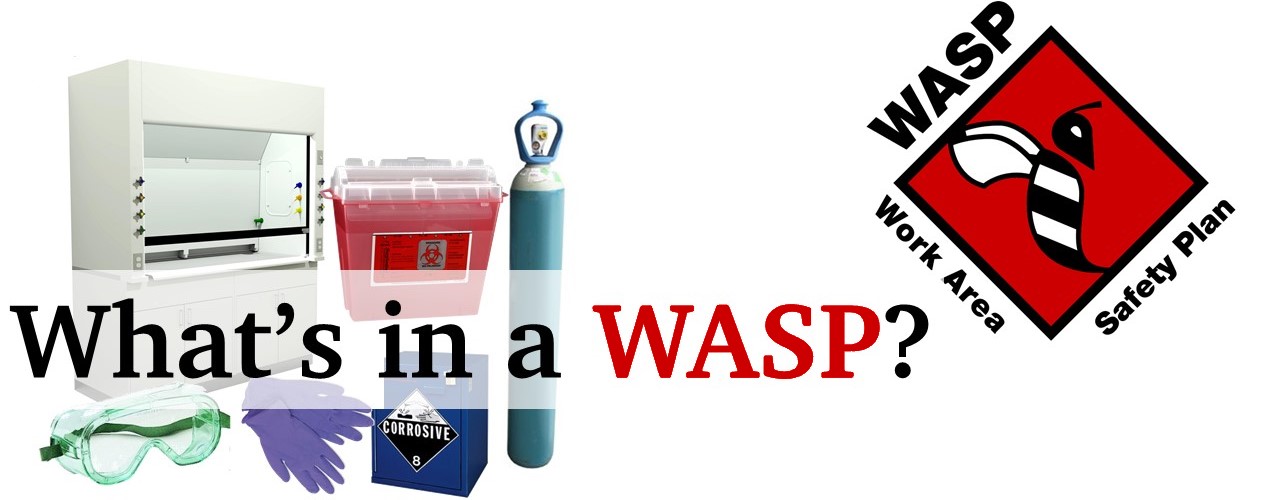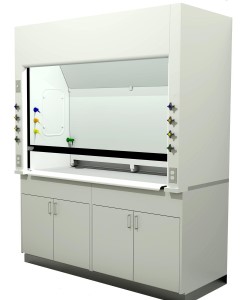
Do you know what a WASP is? If you work in an area that contains chemical, biological, radiation, laser or physical hazards, your work area should have a Work Area Safety Plan, or WASP. In laboratory settings, this plan was formerly called the Laboratory Safety Plan. The decision to change the name to Work Area Safety Plan began in EHS and was passed through the Institutional Laboratory Safety Committee (ILSC). The WASP term is now be used to address both the occupational and academic spaces in which EHS helps to oversee safety.
The responsibility for creating this plan falls to the supervisor of the area. EHS has created a template to ease the endeavor. Areas that should have a WASP include, but are not limited
to, lab spaces, machine shops, studios, field sites, green houses, chemical storage
spaces for custodial and food service staff. If there are hazards present, you should
have a WASP for the area.
area. EHS has created a template to ease the endeavor. Areas that should have a WASP include, but are not limited
to, lab spaces, machine shops, studios, field sites, green houses, chemical storage
spaces for custodial and food service staff. If there are hazards present, you should
have a WASP for the area.
A WASP introduces personnel to the area, identifies the hazards present and provides mitigation and management techniques to prevent injury. Requirements for training and personal protective equipment (PPE) are outlined as well as other general area rules and the emergency response plans for any number of incidents including severe weather, injury or chemical spill. Personnel are required to read the WASP and sign that they understand and will abide by the plan.
Dimitri Pappas, current Associate Professor in the Department of Chemistry & Biochemistry and Chair of the ILSC, had this to say when asked about the importance of Work Area Safety Plans,
"A work area safety plan is a chance for a principal investigator or supervisor to anticipate the site-specific issues his or her students and workers will encounter. In any lab, field site, studio, theater, etc., there
are specific hazards that keep an investigator up at night. It is our job to anticipate those hazards, to understand what is happening at all levels, and to think about what can go wrong. No two research/scholarly activity sites are the same, and a tailored WASP gives an opportunity to effectively communicate to our personnel what are the key hazards and—more importantly—how to mitigate or respond to them."
WASPs are now required to be reviewed every two years according to the University Lab Safety Manual. The WASP should also be updated anytime new hazards are introduced in an area and reviewed by all personnel before the new hazard or operation is added.
WASP Requirements
Section A11 of the University Lab Safety Manual outlines the requirements of a Work Area Safety Plan. Using the EHS-created WASP template ensures you address all requirements. Does your WASP address the following points? Download this checklist here.
- All laboratory location(s) that are covered in the plan;
- Responsible party / parties for the laboratory locations that are covered in the plan;
- Emergency contact information for the responsible party for the laboratory locations, including the Department Safety Officer's contact information;
- Storage locations of SDSs, University Chemical Hygiene Plan, and any other laboratory documents (e.g., SOPs);
- Rules, policies and hygiene practices that are not less stringent than the University Laboratory Safety Manual;
- Procedures to assess performance and operate chemical laboratory fume hoods and other protective equipment;
- Identification of hazards and mitigation strategies in the laboratory, including:
- Physical, electrical, chemical, biological and radiation hazards present
- What physical and health hazards (including Permissible Exposure Limits, if applicable) are posed by hazards present
- Control measures for reducing employee exposure to these
 hazards such as engineering controls, personal protective equipment (PPE), and hygiene
practices;
hazards such as engineering controls, personal protective equipment (PPE), and hygiene
practices;
- The instances under which a laboratory activity requires knowledge or presence of an appropriate responder;
- Provisions for medical consultation and medical examinations (i.e., include information on the Occupational Health Program (OHP);
- Provisions for additional employee protection for work with particularly hazardous
substances (e.g., select carcinogens, reproductive toxins, acutely toxic substances,
etc.). The provisions must cover:
- Establishment of a designated area;
- Use of containment devices (e.g., fume hoods or glove boxes);
- Procedures for safe removal of contaminated waste; and
- Decontamination procedures;
- These provisions may be addressed in a separate SOP (see Section A12 of the University Lab Safety Manual).
- Waste disposal procedures for all waste streams (e.g., chemical, biological, glass, etc);
- Clean-up procedures in case of a spill specified for all hazard classes present (e.g., acid, base, biological, radiological, etc.);
- Guidance on what to do in case of emergency (e.g., fire, medical emergency, severe weather, etc.).
WASP Acknowledgement & Availability
- Is there an acknowledgement sheet that all individuals working in the laboratory have sign that states they have read and understood the plan and will follow what is outlined in the plan?
- Are current training records (i.e., printed training certificates) for all active laboratory personnel, including the PI / supervisor, accessible in the work area?
- Is the WASP readily available to anyone upon request?
- Is there a hard copy of the most recent WASP available in all lab locations?
WASP Review & Updates
- Has your WASP been reviewed in the past two years?
- Was your WASP updated when new hazards, operations or equipment prior to introduction in the work area?
Resources for WASP Development
- Visit the Tools & Templates web page for WASP and SOP templates and other resources for plan construction.
- Many general safety SOPs applicable to most labs across campus have been written by EHS. These SOPs are available for download on the SOPs web page. Word document versions of the SOPs can also be requested to allow laboratories to tailor them to their individual work areas.
- A list of Useful Links has also been compiled that can help in plan construction. University safety policies are largely based on federal, state, and local regulations and other guidance documents included on this list.
- Let us help you! Send your WASP to EHS for review.
- Occupational area (e.g., custodial, Physical Plant, machine shop and studio operations) WASPs can be sent to the Occupational Safety Section in EHS at safety@ttu.edu for review.
- WASPs for academic activities including research and teaching spaces can be sent to the Lab Safety Section at ehs.lab.safety@ttu.edu for review.
Environmental Health & Safety
-
Address
Texas Tech University, 407 Flint Ave, Lubbock, TX 79409 (Mail Stop 1090) -
Phone
806.742.3876 -
Email
safety@ttu.edu
